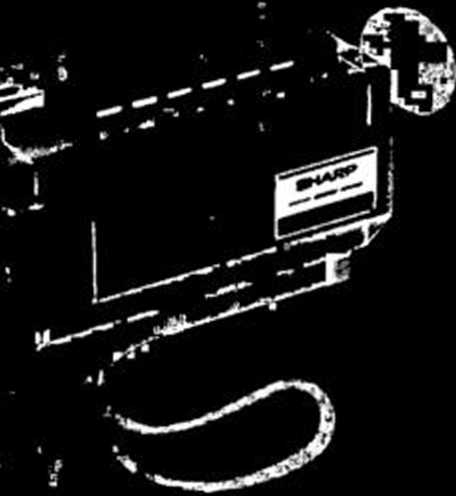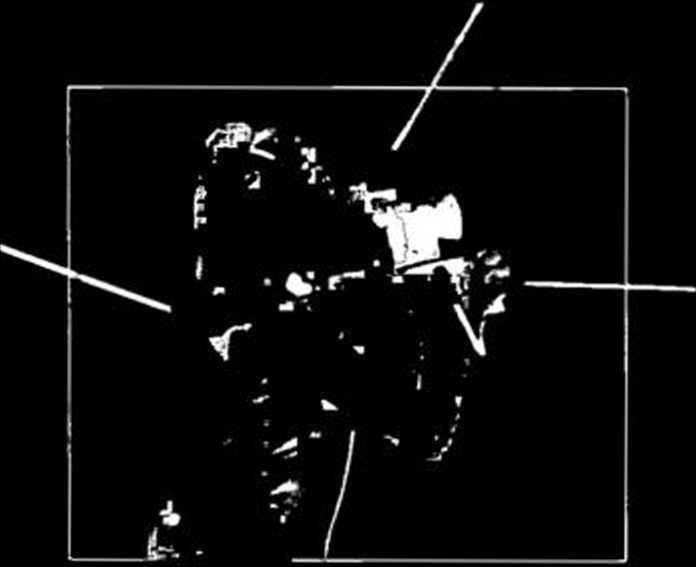5196105932



Sharp*s QC-30 is a low-price ($600), lightwteight (three-pound) color viiico camera with a through-thedens (iTL) optical view-fmiier, a !:2 manuał zoom łens, and a pistol grip.

The shoulder hrace on this JVC CX-6SU color video camera— shown herc with a VF-f'-30lJ electronić view>finder attachment— folds up under the camera body when not in use.
ELECTRONIC
VIEWFINDER
SHOULDER
BRACE

FORWARD
PISTOL
GRIP
In act i oh, a brace rests on the operator s shoulder. bringing the view-finder eyepiece into posilion and distributing the camera 's weight for bet ter stabi lity. Norę forward posil ion of pistol grip.
side to right-side mounting. for example; it can even be rotated so that vou can shcx>t from the hip and still see what you are recording. In other words. it can be attached at any point along the a\is of the camera. Mounting it forward along the side. for instance. enables the body of the camera to be shifted back toward your shoulder and facilitates the use of a shouldcr brace. Some sophisticated elec-tronic viewfinders incorporate such monitoring devices as LEDs or smali nieters. enabling you to check battery power. color balance. etc., without tak-ing your eye off the scene you’re shoot-ing. Of course. sophistication has ns price. But if you plan to do a greal deal of shooting. I doubt you'll be satisfied for very long with anything but the elec-tronic—i.e.. expensive—viewer.
The Lens
The most basie choice here is between a fixed and a zoom lens. A lixed lens isjust that: Its focal length is set and cannot be adjusted. Tochange the framingof a pic-ture. you or the subject musi move toward or away from each other. I.ong-distance telephoto shots are impossible. as are macro shots (except with special auxiliarv lens attachments or a sepurate macro lens). Cameras with single focal -length lenses are usually the least expen-sive. but the price you pay in loss of ver-sati li ty is a heavy one. Some fixed lenses are even permanently atttached to the camera, which means that you can t use accessory lenses or upgrade later.
The most popular lens is the zoom. which can be changed by simply un-screw ingone C-mount lens and screwing in another. Zooms are characterized by a rano—common ones being 1 4 and 1:6— that indicates the degree of change in focal length possible between a w ide angle and a telephoto. Ty pica I ranges are 12 to 72mm. 14 to 84mm. and 16 to 64mm
“Zooming” is accomplished either manually or uuiomatically The manuał zoom uses a knurled ring that’s easy to grasp and control. and often there’s a de-tachable lcver for extra ease of oper-ation. The automatic varietv usualls has
a J
a two-position rocker switch mounted near or on the pistol grip. Holding the sw itch to one side moves the lens toward telephoto. and holding it to the other moves it toward wide anizle. The exact focal length selected (in millimeters) is
indicated by a reference cursor that in-
*
tcrsccts the zoom ring.
The same cursor is used to mark the focusand f/stop rings. Most homo video cameras are focused manually by turn-ing the ring until the scene appears shai p in the viewfinder. Automatic models use sensing circuits to keep the primary subject in focus. In situalions w here the lens (Contmued on page 54)
HIGH HDLLm
Wyszukiwarka
Podobne podstrony:
RealisticSCT 22B Peak-Reading Fluorescent Meters. Dolby* NR, Low Price! Ama&e Soot 30.1960
sudety mapa geologiczna I1 i. I HI ■ r 30 is OPRACOWANIE EKOFIZJOGRAFICZNE DLA
str 30 31 30 m ~ -. iS£f w rozwoju umysłowym od 7-go do 21-go roku życia. W ciągu niewielu lat państ
12 7 It May happen d u ring negotiation that from your point ofview, the most important factor is th
U r® ® O ‘ J© «• * _ *r» ayo«=©^QC^30 U^>^ Q3 JCS O & U książka aplikacje
Biuro fCarżr U& zgrasz*na-uJar^5.OS.2020 f.l3.30-IS.30.pt:SPEED RECRUITING W PRAKTYCE.JAK SKUTE
Back TWO UNFORGETTABLE ROMANCES FOR ONE LOW PRICE!§NCWBOUNI) Wnąjsll) Romance was the last thingon J
kolor obrazek1 V color management" in Help. This term is searchable From anyColor Settings inFo
• I and sec whethcr it is possible to obtain at lcast a 2-milliampere currcnt rcad
V 198 Arquivos is generally situated in its middle-right region, in contrast with
44194 kolor obrazek1 V color management" in Help. This term is searchable From anyColor Setting
26 lutego 2020 r., 17:30-19:00, Sala Wystawowa B, Auditorium Maximum, ul. Krupnicza 33 Madę with
DSC07420 SUMMARY IS THIS STILL A VILLAGE? The study presents the problem connected with comprehendin
img026 It is strongly recommended for the therapist to review safety instructions with the
więcej podobnych podstron